Weaver species
Choose different species from drop-down list and press 'Go' button. See Full species list.Red-billed Quelea Quelea quelea
IUCN: Least concern Discovery: 005Categories: Quelea, acacias, gum, Linnaeus, nectar, pest, palm,
News items about species
Discovery
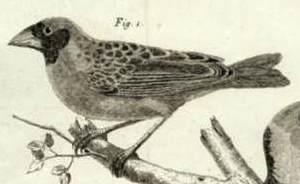
figure from Brisson 1760 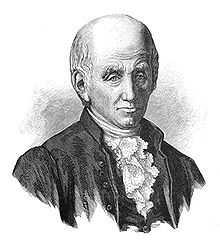
collector of Red-billed Quelea, figure from wikipedia 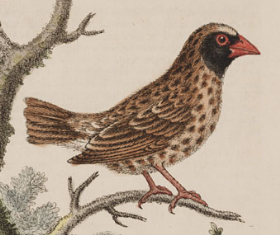
figure from Edwards 1760 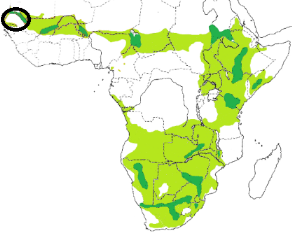
type locality circled IntroductionLinnaeus 1758 described the quelea with a Latin text, but did not provide a reference. He noted that the species came from India, again an error based on ships from the East Indies picking up bird specimens along the African coast on their return to Europe. In his updated 12th edition of Systema Naturae (Linnaeus 1766), he presented the same plumage description in Latin but corrected the type locality to Africa, and listed Brisson as a reference.Presumably Linnaeus had access to Brisson's 1760 draft in 1758. Mathurin Jacques Brisson, a French zoologist, wrote his book on birds in several volumes, each page having 2 columns (one in French and one in Latin). For the quelea, Brisson gave the names "Le Moineau a bec rouge du Senegal" (French) and Passer senegalensis erythrorynchos (Latin). Brisson noted that the quelea originated from Senegal, from where it had been sent to RAF de Reaumur in France by Michel Adanson (the generic name of the Baobab, ie Adansonia, was named after Adanson). Brisson's book has a few engraved illustrations by Francois-Nicolas Martinet, including one of the quelea. Edwards 1760 also illustrated the Red-billed Quelea (in colour) in the same year as Brisson. George Edwards called it the Brazilian Sparrow, not being sure if it came from Brazil or Angola. The painting by Edwards was based on a living male in the collection of Mrs Clayton in England, being a different individual to the type specimen. Linnaeus described many or most of the birds in Edwards, but does not seem to have used the quelea in Edwards (at least not under Linnaeus' genera Loxia or Emberiza). Scientific citationEmberiza quelea Linnaeus 1758 Syst. Nat., ed. 10, p.177 "India". Senegal, ex Brisson (see Linnaeus, 1776, Syst. Nat., ed. 12, 1, p.310)Meaning of namesThe origin of the name 'quelea' is unclear and several authors have debated this without there being enough information to come to a definitive conclusion. No African origin of the name has been found despite extensive searches. Linnaeus probably derived quelea from the Medieval name for quail, ie 'qualia' and 'qualea'. The reason for this is also not clear, and the following possibilities have been suggested by different modern authors:
First English nameBrazilian Sparrow (Edwards 1760)Alternate namesBlackfaced Dioch, Cardinal, Common Dioch, Latham's Weaver-bird, Pink-billed Weaver, Quelea Finch, Quelea Weaver, Red-billed Dioch, Red-billed Weaver, Russ' Weaver, South African Dioch, Sudan Dioch, Uganda DiochCollectorMichel Adanson, a French naturalist who undertook a collecting expedition to Senegal.Date collectedBetween 1748-1754, the time that Adanson spent in Senegal.Locality collectedSenegal.Type specimensNo type specimens known to survive, but the painting of Brisson serves as a type. |
The above is based on Weaver Wednesday 2, a weekly series about the discovery of each weaver species.
This species text first appeared as
Weaver Wednesday [122] - Discovery [5]: Red-billed Quelea on 2014-10-15
1. Basic biology
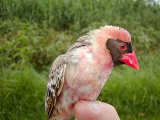 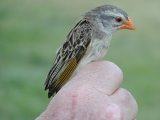
Identification The Red-billed Quelea male in breeding plumage (photo left) has a mask with no pink or varying amounts of pink around the mask. The mask is usually black but is white in some males (see more photos of head plumage variation here). This variation is to allow individuals to recognise each other. In the non-breeding season the sexes are alike, with a dull brown plumage, and a red bill, eye-rings and legs (photo right). Distribution
This species is expanding its range into the Western Cape - the most recent report about this may be read here. Habitat The Red-billed Quelea may occur in very wet and very dry areas, but is most abundant in semi-arid habitats. In West Africa it is concentrated in the Sahel zone. In East Africa the Red-billed Quelea commonly occurs in bushed grassland and cultivated areas. In southern Africa it prefers breeding in dry thornveld. The Red-billed Quelea occurs commonly in farmland, especially in cereal fields. Food The Red-billed Quelea feeds mainly on seeds, typically about 2 x 1 mm in size, but also eats insects and spiders. It feeds on seeds of natural grasses, and damages crops of wheat, sorghum, manna, millet, oats, buckwheat and rice. The Red-billed Quelea is one of the most abundant bird species in the world and its post-breeding population has been estimated to be 1.5 billion birds, leading to its nickname "Africa's feathered locust". It is a significant pest of small grain crops throughout sub-Saharan Africa and is therefore a major threat to subsistence farmers and of economic importance to commercial farmers. Although millions of Queleas are killed each year in government control operations, these birds remain abundant. Breeding The Red-billed Quelea is monogamous and breeds in small to vast colonies - in contrast, most monogamous weavers breed as pairs or in small groups. The nest of the Red-billed Quelea is a small oval ball of grass, with a side entrance at the top under a small porch. Only green, flexible grass is used to build the nest, using about 600-700 grass strips. Nest building is completed in 2-3 days. Nests are built mainly in thornbush with complete grass cover and 20-50% tree cover; using mainly Acacias but also other savanna trees. Colonies may also occur in reeds.
The Red-billed Quelea has one of the shortest breeding cycles of any bird. The breeding cycle takes about seven weeks: nest construction and egg laying overlap and are completed in six days; incubation lasts 910 days; the nestling period takes 1113 days; chicks fledge at age 16 days and start self-feeding at 19 days, and are independent fledglings about a day or two later. This species also builds non-breeding nests through the year. The birds roost in large flocks in reeds or trees, and they leave the roosts at dawn to fly some distance to forage in the early morning. By mid morning they congregate in smaller flocks near their foraging sites to rest for the hot part of the day. While resting they chatter and build nests, which may be partial or complete structures. These midday roost sites with nests provide important information on where the main foraging areas of this major pest species are. Photo right: example of quelea nests in a midday roost (from phown 1658). |
The above is based on Weaver Wednesday, a weekly series about weaver species.
This species text first appeared as
Weaver Wednesday [11]: Red-billed Quelea on 2012-08-29
2. Breeding facts
| Pair bond Monogamous at each breeding attempt, but also itinerant breeding in which individuals may nest at up to three different locations within a season, thus likely that serial polygamy occurs Breeding season mainly Aug-Nov in W Africa, and Jun-Sept in Sudan, Ethiopia and Somalia; in DRCongo, Sept in E and Jan-May in S; two periods, around Dec-Feb and in May-Jul, in Kenya and Tanzania; Feb-Apr in Angola and Zambia, and Dec-Apr in Namibia, Botswana, Zimbabwe, Mozambique and South Africa Nest site placed 1-6 m (mostly 2 m) above ground in thorn tree, sometimes in reeds or sugar cane Nest building built by male, taking 2-3 days Colony size in vast colonies with millions of nests, up to 6000 in a single large tree; occasional small colonies (five pairs) reported Clutch size 1-5 eggs, typically 3 Egg colour pale greenish or bluish, very rarely with some dark spotting Egg size average size of 86 eggs 18.3 x 13.2 mm (South Africa) Incubation incubation period 10-12 days Chicks and nestling period chicks fed by both sexes, by regugitation (even when insects delivered), at Senegal colony male fed 4.7 times per day, female 6 times, nestling period 10-11 days |
Breeding information based on Handbook of the Birds of the World, Vol. 15.
3. Photos of Weaver Nests
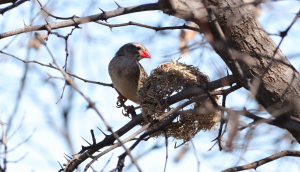 Vm 29556 |  Vm 27993 | 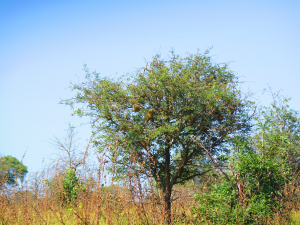 Vm 25829 |  Vm 25229 | 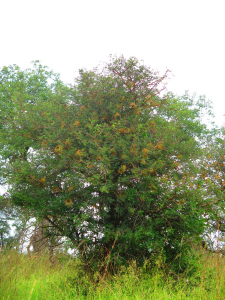 Vm 25227 |  Vm 25181 |
Thumb-nails of most recent PHOWN records - click on one to see its full record
See all PHOWN records for this species here.
PHOWN (Photos of Weaver Nests) provides valuable info on breeding distribution and colony sizes of weavers.
You can contribute by registering and submitting photos at Virtual Museum webpage.
4. Breeding distribution
Google map showing distribution (For species with small ranges you need to zoom in at the correct area to see the range):
yellow blob - range of weaver species; read more about this here.
![]() - PHOWN records with photos
- PHOWN records with photos
![]() - PHOWN records with no photos (Nest Record Cards, other records)
- PHOWN records with no photos (Nest Record Cards, other records)
![]() - Birdpix records
- Birdpix records
![]() - comments on out of range records, or interesting records
- comments on out of range records, or interesting records
![]() - type locality
- type locality
CLICK on the marker on the map to see individual record details.
5. Range changes
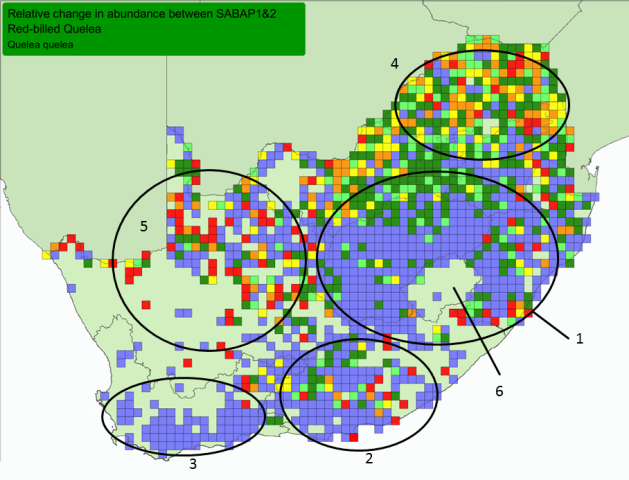
Red, orange and yellow = cells with very large, large, and small relative decreases Blue, dark green and light green = cells with very large, large and small relative increases. Cells = quarter-degree grid cells; Only cells with at least 4 checklists in both SABAP1&2 shown. All cells had this species recorded in SABAP1 or in SABAP2 or in both (more about interpretation at Biodiversity Observations 7.62: 1-13).
Range changes in SA
The points below match the points on the map above. Areas with very large increases include:
Mixed results (increases and decreases):
6. Lesotho - occurs at low density; SABAP2 coverage too low for meaningful results. Range changes elsewhereExotic populations established in foreign countries, eg Spain, Oman, Reunion: Appendix of Dyer EE, Redding DW, Blackburn TM. 2017. The global avian invasions atlas, a database of alien bird distributions worldwide. Nature Scientific Data 4 no: 170041. | |||||||||||||||||||||||||||||||||||
The above is based on Weaver Wednesday 3, a weekly series about range changes in South African weaver species.
This species text first appeared as
Weaver Wednesday 3 [253] - Range changes [16]: Red-billed Quelea on 2017-04-19








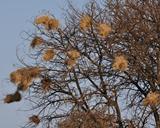


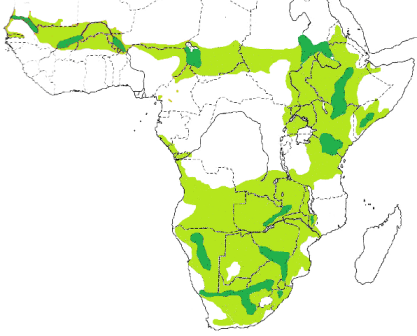 There are three subspecies in which there are small plumage differences in the breeding plumages of males and it is difficult to delineate the exact distribution of the subspecies as there may be large hybrid overlap zones. Approximate distributions are:
There are three subspecies in which there are small plumage differences in the breeding plumages of males and it is difficult to delineate the exact distribution of the subspecies as there may be large hybrid overlap zones. Approximate distributions are:

